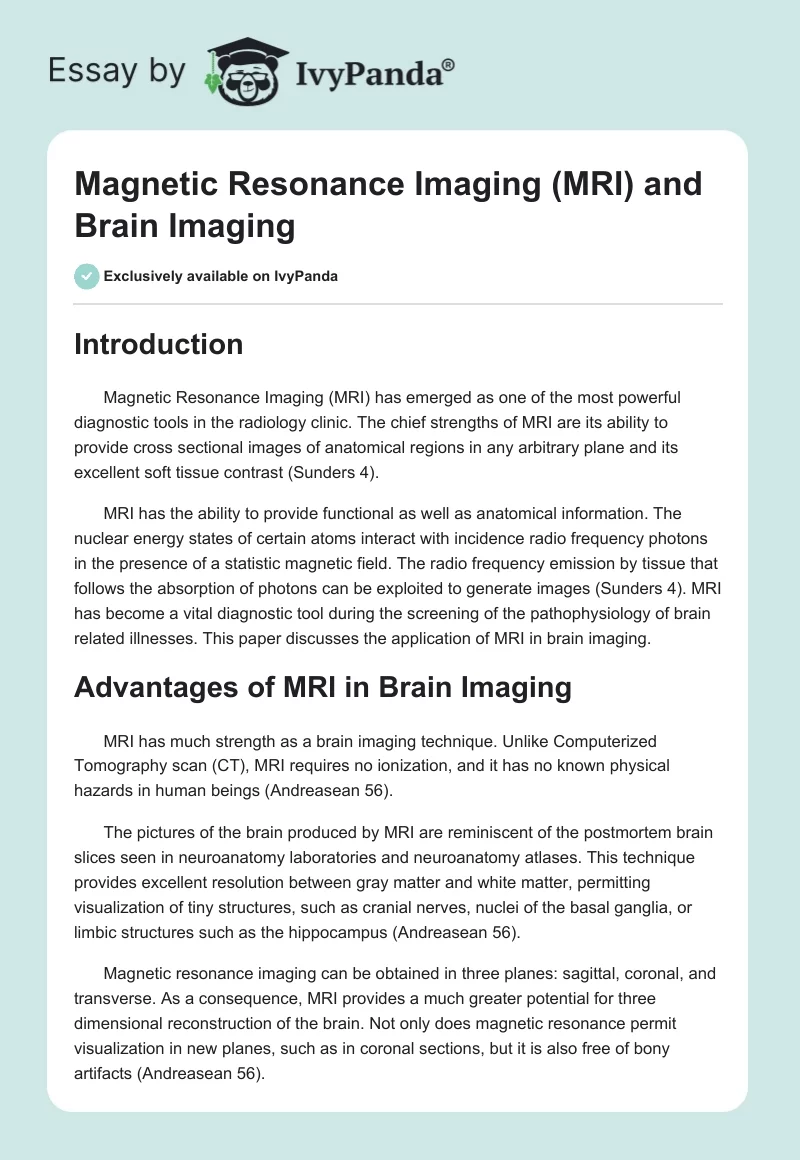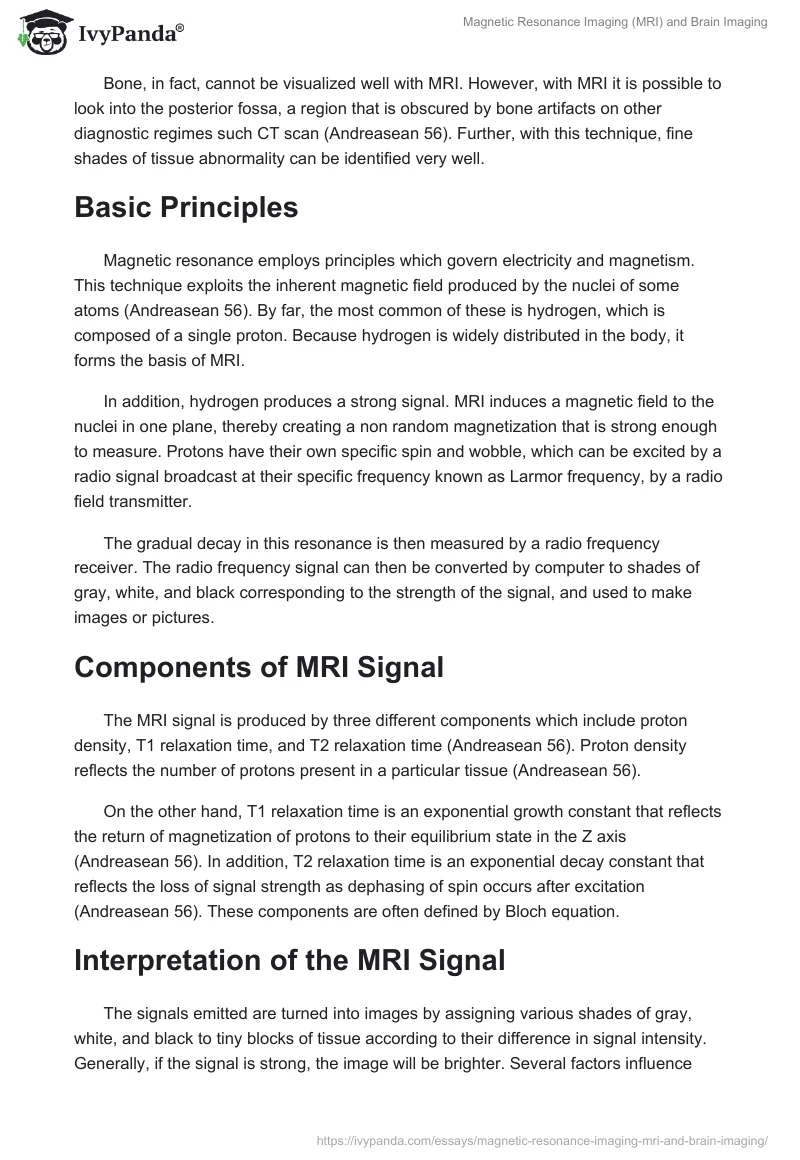Introduction
Magnetic Resonance Imaging (MRI) has emerged as one of the most powerful diagnostic tools in the radiology clinic. The chief strengths of MRI are its ability to provide cross sectional images of anatomical regions in any arbitrary plane and its excellent soft tissue contrast (Sunders 4).
MRI has the ability to provide functional as well as anatomical information. The nuclear energy states of certain atoms interact with incidence radio frequency photons in the presence of a statistic magnetic field. The radio frequency emission by tissue that follows the absorption of photons can be exploited to generate images (Sunders 4). MRI has become a vital diagnostic tool during the screening of the pathophysiology of brain related illnesses. This paper discusses the application of MRI in brain imaging.
Advantages of MRI in Brain Imaging
MRI has much strength as a brain imaging technique. Unlike Computerized Tomography scan (CT), MRI requires no ionization, and it has no known physical hazards in human beings (Andreasean 56).
The pictures of the brain produced by MRI are reminiscent of the postmortem brain slices seen in neuroanatomy laboratories and neuroanatomy atlases. This technique provides excellent resolution between gray matter and white matter, permitting visualization of tiny structures, such as cranial nerves, nuclei of the basal ganglia, or limbic structures such as the hippocampus (Andreasean 56).
Magnetic resonance imaging can be obtained in three planes: sagittal, coronal, and transverse. As a consequence, MRI provides a much greater potential for three dimensional reconstruction of the brain. Not only does magnetic resonance permit visualization in new planes, such as in coronal sections, but it is also free of bony artifacts (Andreasean 56).
Bone, in fact, cannot be visualized well with MRI. However, with MRI it is possible to look into the posterior fossa, a region that is obscured by bone artifacts on other diagnostic regimes such CT scan (Andreasean 56). Further, with this technique, fine shades of tissue abnormality can be identified very well.
Basic Principles
Magnetic resonance employs principles which govern electricity and magnetism. This technique exploits the inherent magnetic field produced by the nuclei of some atoms (Andreasean 56). By far, the most common of these is hydrogen, which is composed of a single proton. Because hydrogen is widely distributed in the body, it forms the basis of MRI.
In addition, hydrogen produces a strong signal. MRI induces a magnetic field to the nuclei in one plane, thereby creating a non random magnetization that is strong enough to measure. Protons have their own specific spin and wobble, which can be excited by a radio signal broadcast at their specific frequency known as Larmor frequency, by a radio field transmitter.
The gradual decay in this resonance is then measured by a radio frequency receiver. The radio frequency signal can then be converted by computer to shades of gray, white, and black corresponding to the strength of the signal, and used to make images or pictures.
Components of MRI Signal
The MRI signal is produced by three different components which include proton density, T1 relaxation time, and T2 relaxation time (Andreasean 56). Proton density reflects the number of protons present in a particular tissue (Andreasean 56).
On the other hand, T1 relaxation time is an exponential growth constant that reflects the return of magnetization of protons to their equilibrium state in the Z axis (Andreasean 56). In addition, T2 relaxation time is an exponential decay constant that reflects the loss of signal strength as dephasing of spin occurs after excitation (Andreasean 56). These components are often defined by Bloch equation.
Interpretation of the MRI Signal
The signals emitted are turned into images by assigning various shades of gray, white, and black to tiny blocks of tissue according to their difference in signal intensity. Generally, if the signal is strong, the image will be brighter. Several factors influence signal intensity. They include proton density, decreased T1, and increase T2 (Andreasean 56).
Tissues with a short T1 relax and return to equilibrium more quickly and therefore give off a brighter signal. Tissues with a long T2 stay in phase longer and give out a brighter signal. Therefore, one must know whether the image is T1 or T2 weighted in order to interpret it. Most pathological processes lengthen T1 and T2 (Andreasean 56). This is attributed to an increase in water content in those tissues (Andreasean 56).
Clinical Applications
A variety of conditions of the brain can be detected using MRI. Examples of brain conditions which can be detected by MRI include “bleeding, cysts, tumors, developmental and structural abnormalities, inflammatory conditions, swellings, or problems associated with blood vessels” (Andreasean 56).
In addition, “MRI can be useful in evaluating problems such as persistent headaches, dizziness, weakness, and blurry vision or seizures, and it can help detect certain chronic diseases of the nervous system, such as multiple sclerosis” (Rosenbloom 364).
MRI is vey helpful in the diagnosis of brain tumors. It gives detailed information on cellular structure, vascular supply, and tumor anatomy (Rosenbloom 366). In addition, MRI provides essential details which reveal the location of the tumor, the type of the tumor, and the size of the tumor.
MRI thus necessitates the effective diagnosis, monitoring, and treatment of brain tumors. The imaging of brain tumors using MRI can be produced in several ways. It can be achieved through “Diffusion weighted MRI, perfusion weighted MRI, diffusion tensor MRI, intraoperative MRI, and awake cranial anatomy with MRI” (Rosenbloom 367).
Rosenbloom argues that this technique is vital in the identification of defects in the brain, which are as a result of alcoholism. In addition, MRI is essential in the identification of changes that occur due to soberness and recurrence. MRI has shown that alcoholism causes “shrinkage in the frontal cortex, 1 underlying white matter, and cerebellum and expansion of the ventricles” (Rosenbloom 368).
Rosenbloom also notes that “these changes are reversible with abstinence, although some appear to be enduring” (368). Imaging studies have shown that the brain has the potential to compensate for cognitive inadequacy. “The myriad concomitants of alcoholism, the antecedents, and the consumption patterns each may influence the observed brain changes associated with alcoholism, which tend to be deleterious with increasing age”( Rosenbloom 368).
The complex features of alcoholism limit the comprehension of the mechanism of alcoholism induced neuropathology. However, “in vivo longitudinal MRI brain studies can be used to understand the development and scope of alcohol dependence” (Rosenbloom 368).
In addition, Edith, Adron and Adolf, argue that multidisciplinary studies have played a key role in the examination of brain function, structure and attending factors.
These studies have been instrumental in evaluating alcohol related damage to the brain. Most importantly, these studies have necessitated the identification of substrates which initiate alcohol related neuropathology. A majority of these studies have concentrated on the neuropsychological sequelae of alcoholism.
This has led to the evaluation of a pattern of sparing and impairment, which has been instrumental in understanding functional deficits. “These studies have elucidated the component processes of memory, problem solving, and cognitive control, as well as visuospatial, and motor processes and their interactions with cognitive control processes” (Edith, Adron and Adolf 127).
The main advantage of MRI in brain imaging science, according to Edith, Adron and Adolf is that “it has necessitated the analysis of the course brain of structural changes during periods of drinking, and abstinence, and relapse” (127).
“MRI studies in patients with phenylketonuria revealed white matter alternations that correlated to most recent blood phenylalanine concentrations as well as brain phenylalanine measured by magnetic resonance spectroscopy”( Rosenbloom 368).
Furthermore, Rutherford et al. conducted a study “to establish a more objective method for confirming tissue injury in term neonates who have early seizures that are believed to be hypoxic ischaemic in origin” (1004). The researchers found out that MRI is essential in the early diagnosis of tissue injury in term neonates who have early seizures.
Conclusion
This paper has noted that Magnetic Resonance Imaging (MRI) has emerged as one of the most powerful diagnostic tools in the radiology clinic. The chief strengths of MRI are its ability to provide cross sectional images of anatomical regions in any arbitrary plane and its excellent soft tissue contrast (Sunders 4). MRI has the ability to provide functional as well as anatomical information. Magnetic resonance employs principles which govern electricity and magnetism.
This technique exploits the inherent magnetic field produced by the nuclei of some atoms (Andreasean 56). By far, the most common of these is hydrogen, which is composed of a single proton. The radio frequency signal is usually converted by computer to shades of gray, white, and black corresponding to the strength of the signal and used to make images or pictures. The MRI signal is produced by three different components which include proton density, T1 relaxation time, and T2 relaxation time (Andreasean 56).
Generally, if the signal is strong, the image will be brighter. Several factors influence signal intensity. They include proton density, decreased TI, and increase T2. Most pathological processes lengthen T1 and T2 (Andreasean 56). This is attributed to an increase in water content in those tissues (Andreasean 56). A variety of conditions of the brain can be detected using MRI.
Examples of brain conditions which can be detected by MRI include “bleeding, cysts, tumors, developmental and structural abnormalities, swellings, inflammatory conditions, or problems associated with blood vessels; MRI can be employed in the evaluation of abnormalities in the brain that occur as a result of alcoholism as well as changes that occur with sobriety and relapse” (Andreasean 56).
MRI has shown that alcoholism causes “shrinkage in the frontal cortex, 1 underlying white matter, and cerebellum and expansion of the ventricles” (Rosenbloom 368).
In addition, “MRI can be useful in evaluating problems such as persistent headaches, dizziness, weakness, and blurry vision or seizures, and it can help detect certain chronic diseases of the nervous system, such as multiple sclerosis” (Rosenbloom 364). The main advantage of MRI in brain imaging science, according to Edith, Adron and Adolf is that “it has necessitated the analysis of the course brain of structural changes during periods of drinking, and abstinence and relapse” (127).
Works Cited
Andreasean, Nancy. Brain Imaging: Applications in Psychiatry. New York: American Psychiatric Pub, 1989. Web.
Edith, Sullivan, Adron Harris, and Adolf Pfefferbaum. “Alcohol’s Effects on Brain and Behavior.” Alcohol Research & Health, 33.2 (2010): 127-143. Web.
Moller, Harald, et al. “Brain Imaging and Proton Magnetic Resonance Spectroscopy in Patients With Phenylketonuria.” Pediatrics 112 (2003): 1580-1583. Web.
Rosenbloom, Margaret. “Magnetic Resonance Imaging of the Living Brain.” Alcohol Research & Health 31.4 (2008): 362-376. Web.
Rutherford, Mark, et al. “Diffusion-Weighted Magnetic Resonance Imaging in Term Perinatal Brain Injury: A Comparison With Site of Lesion and Time From Birth.” Pediatrics 114.4 (2004): 1004-1014. Web.
Sunders, Rajan. MRI: A Conceptual Overview. Berlin, Heidelberg: Springer, 1998. Web.


